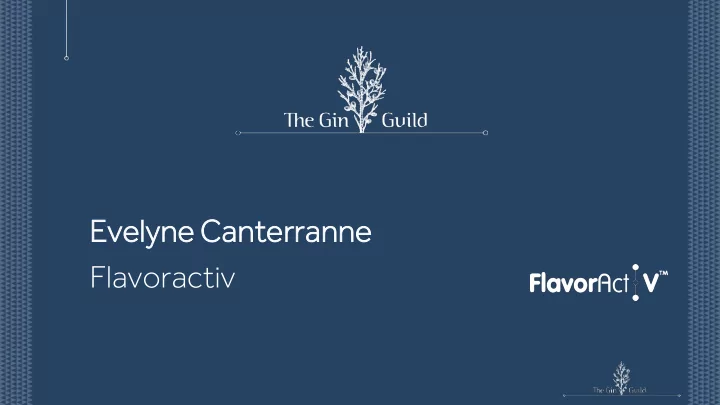

Evel Evelyne Can Canter errann nne Flavoractiv
Structuring Sensory Practices for Excellence in Gin Quality & Innovation
Gin – a widely consumed distilled beverage Neutral Juniper Spirits Berries Variety of Botanicals (e.g., Angelica, Orris root, Caraway, Coriander , Lemon grass, Liquorice, etc ) Available in different styles of Gin with predominant taste of juniper berries
Neutrality of base for spirit • Regardless of style, neutrality of base spirit in Gin is extremely important • Off-notes from impurities and/or contamination cause adverse effect on aroma & flavour profile • Consistency and shelf life stability influence the sensory quality of final products
Grain Neutral Spirit (GNS) or Extra Neutral Alcohol (ENA) • High-purity potable ethanol ( 96 % ABV ) from agricultural crops • Base for Gin , premium vodka & several speciality spirits • Neutral smell and taste and identification & removal of negligible impurities (congeners) are critical • Despite multiple distillations traces of congeners cause unacceptable odours
Why Purity of Neutral Alcohol • Any off note from impurities/contamination adversely affects • Gin sensory quality • Gin Aroma & flavour profile • Consistency and stability • Effect on post-consumption well-being ( Taste , Hangover, Toxicity) • Neutral spirits can exhibit objectionable off notes beyond Method Detection Limit of analytical instruments but fall within sensory threshold of panellists • Structured sensory panellists training and regular proficiency calibration enhances trustworthiness of sensory quality decisions
Typical off notes in Neutral Alcohol Affecting Gin Sensory Quality
Sensory Analysis vs. GC Analysis Data of Neutral Alcohol Neutral Strength Ester Acetaldehyde Higher Diacetyl, 2,3 Methanol Sensory Sensory Remarks Spirits g/100LAA g/100LAA alcohol ppm Pentanedione g/100LAA Description, Secore % Samples / Fusel Oil ppm Off- Notes 0-10 g/100LAA Scale NS 1 Grain 95.9 ND ND 0.1 ND ND 1.5 Diacetyl 5.0 GC - OK Sensory - Not OK NS 2 Grain 96.4 ND ND ND ND ND 0.2 Sulphury 5.0 GC - OK Sensory - Not OK NS 3 Grain 96.5 ND ND ND ND ND 2.5 Fusel/Impure 4.6 GC - OK Spirit Sensory - Not OK NS 4 Grain 95.8 ND ND ND ND ND 0.8 Papery 5.2 GC - OK /Oxidised Sensory - Not OK NS 5 Grain 96.1 ND ND ND ND ND 1.1 Kerosene 4.0 GC - OK Sensory - Not OK g/100LAA (gram per 100 litres Absolute Alcohol) Neutral spirits can exhibit objectionable off notes beyond MDL of analytical instruments but fall within sensory threshold of panellists
GMP Flavours Facilitates Retronasal Tasting The Nose & Mouth are connected. Molecules released into the air inside our mouths as we chew and swallow travel up through the retronasal passage into the nose, then move up and contact the olfactory epithelium. Flavour is the combination of true taste (sweet, salty, sour, bitter) and retronasal olfaction and mouthfeel
Structured Training in developing sensory skills
Sensory Methods & Procedures Analytical (Objective) - Product Oriented Discriminative Quality /quantity of a Characteristic Descriptive Similarity /Differences between products Standardisation Fewer People, selected, trained Affective (subjective) - Hedonic (Liking) People /Consumer Oriented Acceptance/preference of a product Acceptability First impressions Preference Personal reaction Larger number of panellists, representative of population
Sensory Evaluation Methods ANALYTICAL SENSORY ANALYSIS Sensitivity Quantitative Qualitative Discrimination Descriptive Threshold Scaling Duration (Difference) Analysis Duo-trio Ranking Time-Intensity (TI) Temporal Triangle Interval Dominance of Sensations (TDS)
Sensory Evaluation Methods for Neutral Spirits • Scoring (Ratio Scale 0 -10) • Threshold or Sensitivity Tests • Difference Tests • Duo Trio , Triangle , Tetrad etc. • Difference from Control (DFC) • An adaptation of Degree of Difference test • Developed to deals with batch to batch variations. • A discrimination sensory test with an identified control • Evaluation by perceived difference from control • Scale range from “Not Different” to “Extremely Different”
GMP Flavours For Sensory Panel Training & Proficiency Calibration Acetaldehyde Earthy Isovaleric Pungent, Solvent, Green Apple Dusty, Chalky Cheesy, Sweaty, Rancid Skin, Leafy, Grassy, Cardboard Butyric Ethyl Acetate Mercaptan Baby Vomit, Rancid, Cheesy, Fruity, Nail Enamel, Solvent, Sulphury, Drain, Gas, Putrid Acetone, Paint, Glue Butane-like Brett-Barnyard Ethyl Butyrate Metallic Band-aid, Medicinal, Tropical Fruits, Pineapple, Metal, Iron Rust, Blood-like Sweaty Horses Banana, Mango Diacetyl H2S Musty Buttery, Butterscotch, Creamy, Sulphury, Rotten Egg Corky, Musty, Dampness Toffee Plastic Styrene, Acrylic, Solvent DMS Isoamyl Acetate Sweetcorn, Cooked Cabbage, Fruity, Banana Tomato, Shellfish, Oyster-like Dry Hay / Plastic Iso Amyl Alcohol Hay-like, Straw, Husky Fusel Oil, Fruity, Banana, Estery
Proficiency / Validation – why? • To demonstrate the reliability of tasters, and therefore of the sensory quality system • To allow initiation of corrective actions; refresher training / focussed training, removal from the panel, etc. • To assure that you are measuring what you think you are measuring • Monitor trends in sensory assessments over time • Monitor individual capabilities as part of the training programme • Demonstrate competence to third parties such as accreditation bodies or customers Validated trained panel = Calibrated Instruments (Objective Results) Ultimately Improve Quality, Taste and Consistency of your global brands
Sensory Proficiency & Validation Produced to GMP Quality Standards Colour coded format for easy use Provided in Pharmaceutical blister packs – protected from air and moisture and easy to use Documentation and labels provided Test to results takes 30 mins
Method of Proficiency Assessment? • Measures & Calibrate sensory skills of spirit assessors • Gives a common language of typical off-notes in NS • Ultimately improves quality of the produced NS & NS based spirits beverages
Sensory Proficiency Scheme – Methods of Validation Flavour Identification Validation: • Individual flavour identification using standard terminology Rank Rating Validation: • Discrimination of different flavour intensities and scale them accordingly In Profile Validation: • Primary focus on IN or OUT / meeting the brand‘s sensory profile – used by spirits customers
Assuring Value from best sensory practices
Summary Off-notes and taints are detrimental to gin. Combine analytical results with those of a trained and validated tasting panel to prevent off-note or taint exposure to the public. Train with GMP Flavour Standards, maintain with taster proficiency.
Any Questions?
Recommend
More recommend